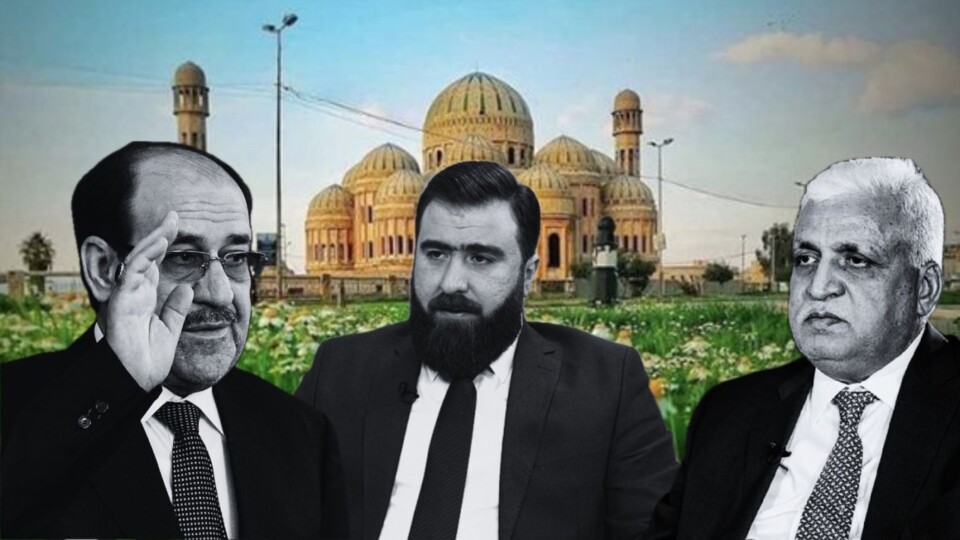A mosque or a church? What did UNESCO discover under Al-Nouri Mosque that was blown up by ISIS?
Discovery under the ruins of Al-Nouri Mosque where Al-Baghdadi preached and that was blown up by ISIS
Discovery under the ruins of Al-Nouri Mosque where Al-Baghdadi preached and that was blown up by ISIS
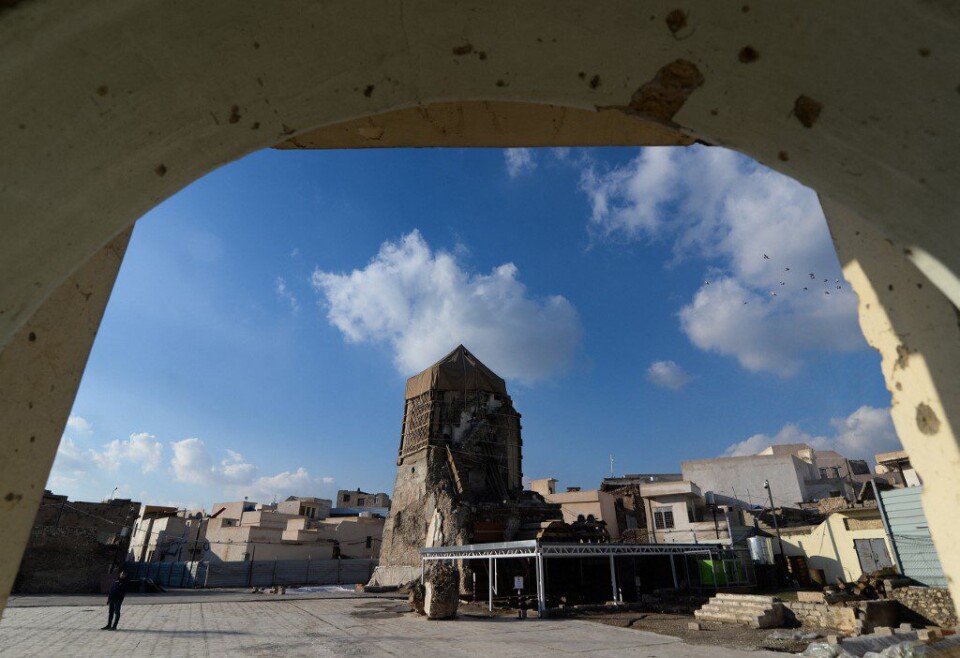
Nineveh Investigative Team, Translated by Walaa Rayya
Archaeologists, who were busy assembling the ruins of Al-Nouri Mosque (1170 AD) to rebuild it within the “Revive the Spirit of Mosul” initiative led by UNESCO, had no idea that another archaeological site older than the mosque is located directly under their feet.
The discovery, which took place at the beginning of 2022, is partial compensation for the city’s heavy losses of important archaeological monuments that ISIS managed to destroy during its period of control over all of Nineveh between 2014-2017.
UNESCO stated that the discovered site date to the twelfth century, and consisted of four prayer halls located under the chapel of Al-Nouri Mosque, which represents the oldest mosque in Mosul and included the famous Al-Hadba minaret known for its inclination, which was destroyed by ISIS on June 21, 2017.
A statement from the organization that supervises the reconstruction of Al-Nouri with funding from the United Arab Emirates, indicated that the discovery was made after the launch of an excavation project in August 2021 and it shares “a message of hope to the people of Mosul, Iraq, and the world, because it sheds light on the ancient history of the country and gives the chance to discover more about his rich heritage”.
Khair Al-Din Ahmed Nasser, director of the Nineveh Antiquities and Heritage Inspectorate, says that the discovered site belongs to the Islamic Atabeg era in 1127 AD, which would reinforce the importance of Al-Nouri Mosque in historical terms.
He adds that it consists of four rooms or halls connected and built of stone and plaster, each one is three and a half meters wide, three meters high and located approximately six meters below ground level.
He points out that the site includes basins of limestone that were used for ablution, the depth of each basin is 60 centimeters, and “their floor was wider than the floor of the prayer hall, which was built in the forties of the last century”, he meant the updates that took place on Al-Nouri Mosque at that time.
While some people who are interested in heritage affairs think that discovered site may be the construction of the mosque itself, which has been reconstructed several times during the past decades, others think that the site is an even more ancient mosque or church.
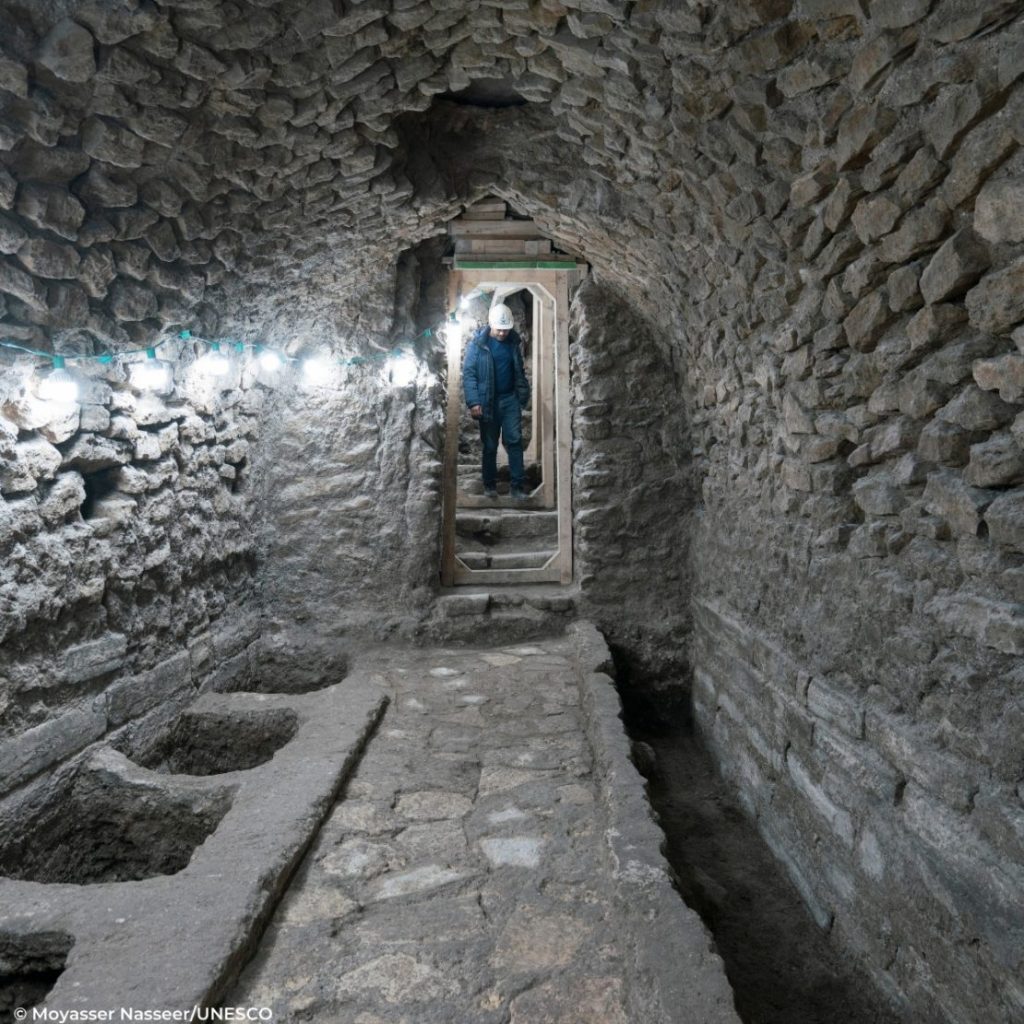
Mosul is a multi-religious city, and the area in which Al-Nouri Mosque was built, which is called the Old City, includes Al-Tahera church, Our Lady of the Hour Church, and mosques with the names of prophets such as the Prophet Gerges, as Mosul is sometimes described as the city of prophets.
The symbol of Mosul where the “caliphate” was declared
On July 5, 2014, twenty-five days after IS took control of Mosul, the jihadist group’s leader gave a speech in Al-Nouri Mosque, or the Great Mosque is known for its leaning minaret, which is one of the most famous landmarks of the city that gave it its nickname “the hunchback”, and he presented himself as the successor to what he called the Islamic State.
Al-Nouri Mosque is the last landmark destroyed by the organization before its defeat in the summer of 2017 and the end of its control over Nineveh. The last thing IS militants did was to blow up Al-Hadba minaret, which had remained standing, leaning protectively over the city for more than eight centuries.
However, the group did not provide any reason for destroying the mosque and its Hadba Minaret, unlike the rest of the archaeological sites and shrines that were destroyed by IS on the pretext that venerated tombs and shrines are symbols of idolatry and thus contradicted their belief.

According to the different versions of facts, Nouri al-Din al-Zanki built the mosque or completed its construction in 1170 AD. At that time al Mosul, where Christians, Muslims, Jews, and other sects had been living together, had only one mosque, the Umayyad Mosque.
According to Hassan Abdel-Wahhab Ghazi, a specialist in architecture, Al-Hadba minaret was not built in a leaning shape, but it became tilted later because of the materials from which the minaret was built (brick and plaster), as he and other historians see.
He said that the internal cavity was made of plaster, and because the lighthouse was about 45 meters high including its base, the winds made the lighthouse gradually lean in structure towards the east until it took its final inclined shape after the plaster had hardened.
Others believe that the reason is the great difference in temperature between summer and winter in Mosul, while others believe that it is related to the building foundations of the minaret.
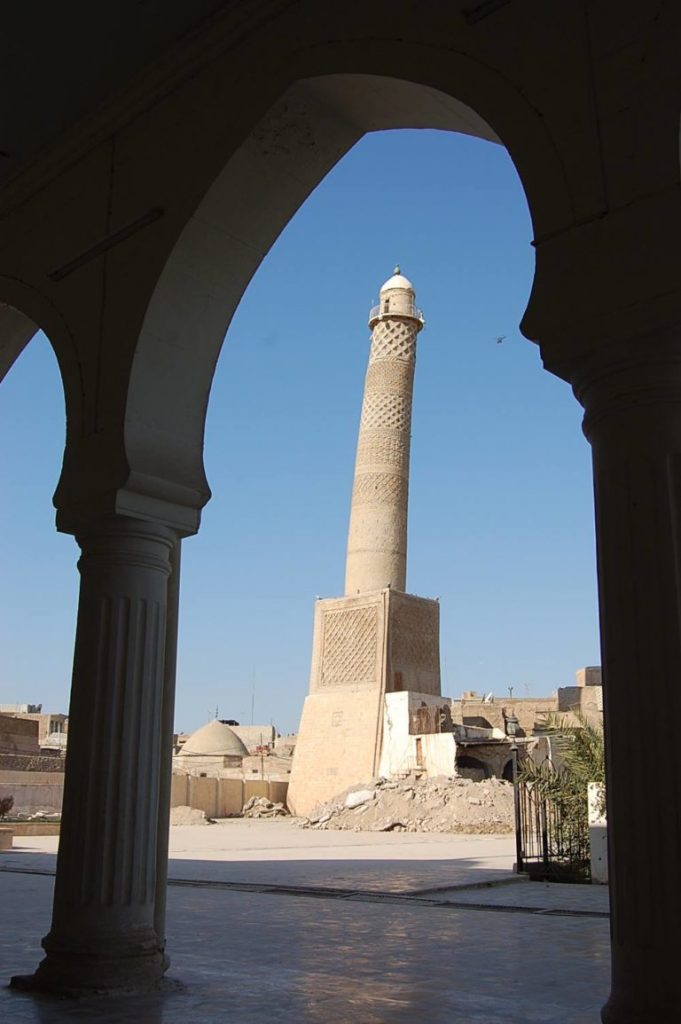
Historical myths and narratives
Ghazi points out that the name of the Minaret was associated with many myths and folk tales that people circulated from generation to generation. Some people thought that the reason for its inclination was the minaret’s curtseying in respect to the Prophet Khidr, who once passed by it, or tended to Ali Bin Oubay, who visited one of his sons in Mosul. Christians said that it was inclined to the Virgin Mary, who many of them believe is buried near the Erbil governorate, east of Mosul.
“Its name was associated with a very important and authentic fact that confirmed the strength of the social fabric of Mosul about a century ago,” said Ghazi, “a huge gap occurred in the body of the lighthouse, at twenty meters high. The builders were unable to do anything about it because of its height and their lack of special types of equipment, so a Christian builder named Aboudi Al-Tambourji who was originally from the governor of Kirkuk volunteered to restore it, and when he succeeded to do so, he refused to receive any material compensation for his work.” He added.
The people of Mosul, the majority of them were Muslims and still are, remember that position and mention it to emphasize the social relations between Muslims and Christians. After the liberation of Mosul from ISIS, many activists promoted calls for the reconstruction of the churches that had been destroyed by the organization as a favor they owe Al-Tambourji.
Aid Khaled (56 years old), a resident of the Al-Sa’a area near the Al-Nouri Mosque, said that he had always believed that the groundwater below the base of the minaret would cause its collapse after cracks appeared in its base and body before 2014.
“We were waiting for the government’s promises to restore and preserve it. We could not imagine our life without it. It gave us strength and determination and its presence makes us feel proud because it resisted and did not fall despite its old age and inclination.”
He added with regret: “But they destroyed it in the end, without caring about the feelings of millions of Muslims who used to look at the mosque with reverence, and now, years after their crime, every morning when I go out of my house and face the emptiness on the place where the minaret occupied, I feel that I have lost something very dear, something that can never be replaced.”
In peacetime in Mosul, The Hadba minaret was a shrine for tourists and pilgrims from eastern Europe and Asia on their way overland to Mecca in Saudi Arabia. Successive Iraqi governments also put the Hadba picture on securities and stamps.
Its name was given to a residential neighborhood, a street, an institute, schools, a health center, and a college in the city of Mosul, as a popular symbol that its fame eclipsed the fame of other archaeological areas of more historical value than the Al-Hadba minaret, such as Hatra, Nineveh, Nimrud, and Khorsabad, which are cities located inside or around Mosul.

Revive the Spirit of Mosul
UNESCO, with funding from the United Arab Emirates, sponsored the reconstruction of Al-Nouri Mosque and its Al-Hadba minaret, relying on dozens of its experts, in cooperation with about forty scholars affiliated with the Iraqi Antiquities and Heritage Inspectorate, as part of a project called Reviving the Spirit of Mosul, which includes the reconstruction of several archaeological sites, including Al-Nouri Mosque, churches and heritage buildings that were destroyed by ISIS fighters.
In 2020, the agency launched an international competition for the best design of Al-Nouri Mosque, in which 123 design teams participated. On the fifteenth of April of the following year, the jury that consisted of nine members, two of them Iraqis, announced the winning of a design called “Courtyards Dialogue,” presented by a team of eight Egyptian architects headed by Salah El Din Samir Hareedy.
The agency noted that the reason for choosing the Egyptian team’s design is to reconstruct the historical prayer hall in Al-Nouri Mosque, and achieve harmony between the pillars of the complex, which is the largest public place in the old city of Mosul and its urban surroundings, through open public spaces with five entry points from surrounding streets.
The agency representatives confirmed that the prayer hall will look as it did before the 2017 destruction of Al-Nouri Mosque, and it will feature notable improvements in the use of natural light and expanded spaces for women and dignitaries, that will connect to the main hall through a semi covered open structure which could also serve as an open space for prayer.
Also, enclosed gardens evocative of the historic houses and gardens that were located around the prayer hall before its remodeling in 1944 will be created.
As soon as the design was announced, it met with wide popular and official opposition and was severely criticized for its violation of the existing architectural designs in the old city, where the Al-Nouri Mosque is located, as critics found that the winning design had a modernist character that did not fit the history of Mosul.
Junaid Al-Fakhri, an archaeologist, described the design as a cube, which did not take into account the civilization of Mosul and the common architecture of its heritage buildings, and held the concerned official authorities fully responsible if the reconstruction was approved according to this design.

On the governmental side, the Inspectorate of Antiquities expressed its objection with a lengthy report that contained 80 pages, in which it noted its experts’ observations on the winning design, which they considered to violate the determinants that UNESCO had mentioned in the competition conditions.
These criticisms took place in the street as well and took the form of a wide campaign on social media, led by activists angry at what they described for days as a conspiracy to change the archaeological and heritage face of Mosul.
UNESCO was forced to hold several seminars in which a number of its employees participated, and gave a detailed explanation of the design, and they succeeded in calming and reassuring the public that the Al-Nuri Mosque and its minaret would be the same again.
Ahmed Al-Omari, head of the Department of Architecture at the University of Mosul and a member of the Al-Nouri Mosque Design Competition Committee, said that the mosque will keep its previous design, and the cubic design will be for modern buildings like “the library, the museum, the Al-Nouri school, and the Islamic institute.”
Al-Omari indicated that the winning design took into account the functional and visual aspects of the mosque and that it is consistent with the fabric of old Mosul and the urban context and heritage alleys, stressing that it links the past and the present.
Al-Omari and other specialists were afraid that the objections would lead to the UAE withdrawing its funding and thus the Al-Nouri Mosque would not be reconstructed due to the economic situation in Iraq and the Mosul need for infrastructure that had been destroyed during its liberation war from ISIS 2016-2017.

A blackout on the results of the excavations
A source in the Sunni Endowment, which is the owner of the Al-Nuri Mosque site, stated that the discovery was made in the last quarter of 2021, but the Antiquities Authority kept it in secrecy and did not disclose it until the excavation work was completed. He said that the first stage of the reconstruction of the Al-Nouri Mosque began with the arrival of a team of Egyptian scholars in March 2022 and is continuing.
Ghassan Abdel Aziz, a writer, and a researcher, suggested the postponement of the announcement of the discovery of the site under the Al-Nouri Mosque, to avoid popular objections that might impede construction or stop it completely, as happened with the Prophet Yunus Mosque that ISIS blew up days after its control of Mosul in June 2014.
He explained that the Sunni Endowment laid the foundation for the reconstruction of the Prophet Yunus Mosque after the liberation of Mosul in 2017, but the announcement of the discovery of the palace of Esarhaddon, the Assyrian king, under the place where the mosque was built, prevented the reconstruction of the mosque.
“Therefore, UNESCO decided that it should take announcing the matter slow to make sure that what was discovered were prayer halls and ablution rooms, meaning that nothing requires stopping the work of rebuilding the Al-Nuri Mosque.” He said.

But what is the truth about the structures that were found under Al-Nouri Mosque? The answers to this question were brief and did not exceed what was announced by UNESCO in a few lines, and we found in historical sources that historians had referred to it, including Imad ad-din al-Isfahani in the book (Al-Barq Al-Shami – the Levantine Lightning).
He mentioned that Nur al-Din al-Zengi upon his arrival to the city of Mosul and his control over it without any resistance in the year 566 AH, wanted to build the mosque that bore his name later in a place that was occupied by downtown ruins. The people told him that the place was sinister and everyone who wanted to build there died instantly, but Al-Zengi insisted on building the mosque, indifferent to what is being said. He insisted on building the mosque not caring about what is said.
Others in Mosul believe that the Al-Nouri Mosque was built on the ruins of a church called “The Forty Martyrs,” which in its turn was built on land that was formerly the Church of “Saint Paul,” because Mosul was swarming with churches and many Christians were living there, but their numbers decreased from generation to generation until they became a minority today.
The writer Ghassan Azizi indicates that a German orientalist named Ernst Herzfeld wrote a study on the Al-Nouri Mosque in the early twentieth century where he mentioned that the mosque was built over a mosque built by Saif al-Din Ghazi I in 543 AH, which was originally built on an anonymous tomb.
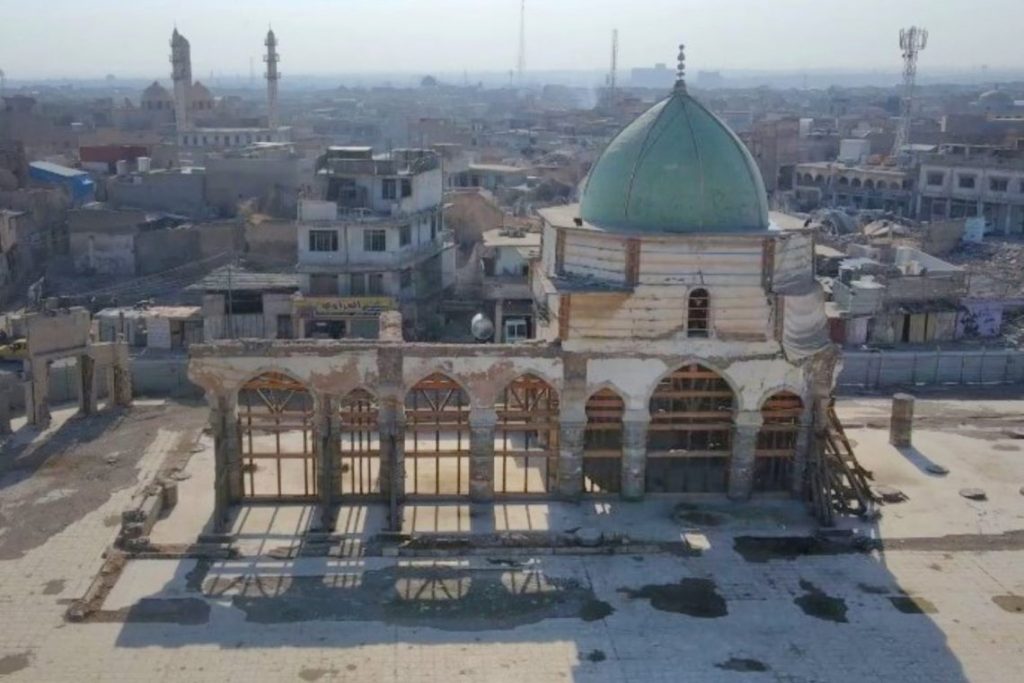
According to an employee of the Antiquities Inspectorate, the discovered site will not affect the process of building the mosque and its annexes with the lighthouse, rather it will be an additional landmark and may be available to tourists once everything is completed, as he mentioned.
No matter what effect the building discovered under the Al-Nouri Mosque will have, it confirms two things: the entire ancient area of Mosul needs careful excavation, and removing any stone from its land, will put you in front of discoveries that will give Mosul an additional historical value as archaeologists say.
But it will mean disruption of the reconstruction projects of some sites. Perhaps the hill of the Prophet Yunus Mosque is a vivid example of this, as nearly four years have passed since the foundation stone was laid by the Sunni Endowment Office, and not a single inch of the building has been raised from the ground.
The report was produced with the support of the Investigative Network (NERIJ).


